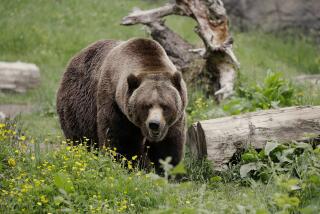Wolves not endangered in Rockies? Activists arm for fight
SEATTLE -- Wolves are finally poised to be taken off the Endangered Species list in the Northern Rockies, with the federal government recently approving Wyoming’s plan for managing its own wolves.
The U.S. Fish and Wildlife Service announced Friday that the wolf population in Wyoming is officially “recovered,” the same pronouncement that’s been made about wolf populations in Idaho and Montana. That decision -- when it takes effect at the end of September -- marks the end of a wolf-recovery process that began in the region nearly 17 years ago.
But the fate of the once nearly extinct predator is far from settled. Wolf advocates fear that the animals could be beaten back out of the Northern Rockies by state laws that have gradually expanded the hunting and trapping of wolves nearly everywhere except in national parks.
New lawsuits are expected to be filed soon in Montana, where conservationists argue that newly authorized wolf traps could catch threatened Canada lynx. Legal action is also expected in Wyoming, where critics argue that the state’s plan for managing wolves could leave them vulnerable to wholesale killing through most of the state.
Attorneys for Earthjustice, which expects to challenge the Wyoming plan, said ranchers in that state have talked about the possibility of using tethered dogs as live bait to lure problem wolves toward the waiting guns of ranch owners.
“Wyoming has a law that says you can kill wolves … at any time of year in circumstances where they’re threatening livestock or pets,” Tim Preso, managing attorney for Earthjustice in Montana, told the Los Angeles Times. “The unseemly spectacle we’ve seen at some public meetings is folks who have anti-wolf sentiments have been confirming with state Fish and Game personnel that it would be legal to go adopt a dog from the pound, stake it out in wolf territory and shoot wolves as they come to attack the dog.”
The Idaho Statesman reported on Idaho state Sen. Jeff Siddoway, who proposed a measure that would have allowed live baiting of wolves in that state.
As an example, Siddoway told a legislative committee that his wife’s dog, Sophie, could be placed on a 20- to 30-foot leash while he hid nearby with a gun and then sounded an electronic wolf howl. “You try to get Sophie to chime in with the wolves,” the Republican legislator said, according to the Statesman. “If they come down out, just start shooting.”
Siddoway’s Idaho sheep company includes summer pastures in Wyoming.
Wyoming Game & Fish Department spokesman Eric Keszler said he was uncertain whether live baiting would be permitted under state regulations.
At issue in the upcoming legal challenge will be a provision in Wyoming’s plan that manages wolves as ordinary trophy hunting targets in the northwest corner of the state near Yellowstone and Grand Teton national parks, with full hunting regulations and quotas. That provision designates wolves as predators in the remaining 83% of the state, meaning they can be killed at any time in any numbers.
U.S. Fish and Wildlife Service officials say the vast majority of the state’s wolves are in the more-protected northwest corner. Further, they say, the plan includes a flexible zone that extends the normal hunting regulations about 50 miles south of the town of Jackson between October and February. That zone is intended to protect wolf numbers at a time when young wolves normally disperse to new territory to form or join new packs.
“One of the great concerns we have is that what we do know is that wolves disperse at all times of the year, and when they do, it usually takes them about five months to move from one of these population centers to another. So just on those terms, it doesn’t seem very well-calculated to solve the problem,” Preso said.
Wolf advocates also are concerned about the exemption allowing wolves in any zone to be killed when threatening people or livestock. The provision for a “predator” zone with few or no controls on wolf killing could lead Idaho and Montana, which presently have no such free zones, to try for similar exemptions, the advocates say.
“Perhaps we could not expect more from Wyoming, but the Fish and Wildlife Service must have higher standards for wolf recovery,” Mark Salvo, wildlife program director for WildEarth Guardians, said in a statement signaling that his group, too, intends to pursue new litigation.
Keszler, the Wyoming Game and Fish spokesman, said the new regulations provided trophy hunting protections for nearly all wolves currently in the state, adding that few or none are outside the northwest quadrant.
“Some are [outside in the predator zone], but they’re right on the edge of it. There’s none around here in Cheyenne or Casper,” he said. “Just the way it’s worked ever since wolves have been reintroduced into Wyoming, they can’t make it in those areas. As soon as they get into those areas, they start getting into conflicts with livestock. It just doesn’t make sense to have wolves in that part of Wyoming.”
Wyoming during the last census in December 2011 had 328 wolves, 224 of them outside Yellowstone National Park. The state is required to maintain at least 100 wolves in 10 breeding pairs outside Yellowstone and the Wind River Indian Reservation — a number conservationists say is too low if wolves are to survive. State officials have not set specific quotas yet but say they have no intention of going as low as 100 wolves.
Across the three-state region, federal officials estimate that there are more than 1,774 adult wolves, and most suitable wolf habitat is now at or above long-term carrying capacity.
Wolf advocates argued vociferously against Montana’s recent expansion of its wolf hunting regulations to allow trapping, as Idaho already does.
Four conservation organizations filed notice of intent to sue last month over the trapping provisions, arguing that Canada lynx already were being killed and injured in traps and would become even more vulnerable if wolf traps were added into the mix.
On Aug. 30, activists held a rally in Coeur d’Alene, Idaho, to memorialize the more than 540 wolves killed in Idaho and Montana wolf hunts since the species was removed from the endangered list in those states in 2011. Last year’s tally in Idaho alone was 379 wolves — not counting wolves killed by government wildlife agents seeking to prevent livestock predations.
“Of the 379 wolves killed in last year’s hunt, 40 were puppies, 56 suffered in leg-hold traps before being killed, and another 67 choked to death in snares,” Ann Sydow of the Northern Idaho Wolf Alliance, one of six organizations sponsoring the rally, said in a statement.
The U.S. Fish and Wildlife Service says that, despite wolf advocates’ concerns, the recovery of wolves in the region so far has worked: Healthy populations of wolves have been established in all three states.
“The return of the wolf to the Northern Rocky Mountains is a major success story, and reflects the remarkable work of states, tribes and our many partners to bring this iconic species back from the brink of extinction,” director Dan Ashe said in a statement. “The wolf population has remained healthy in Idaho and Montana, and we’re confident that the Wyoming population will sustain its recovery under the management plan Wyoming will implement.”
ALSO:
New York arrested nude model, now it’s set to pay her $15,000
‘Organic’ a waste of money? Depends on your reason for buying it
Judge: Massachusetts must pay for murderer’s sex-change surgery
Follow Kim on Twitter @kimmurphy. Email: [email protected]
More to Read
Sign up for Essential California
The most important California stories and recommendations in your inbox every morning.
You may occasionally receive promotional content from the Los Angeles Times.










